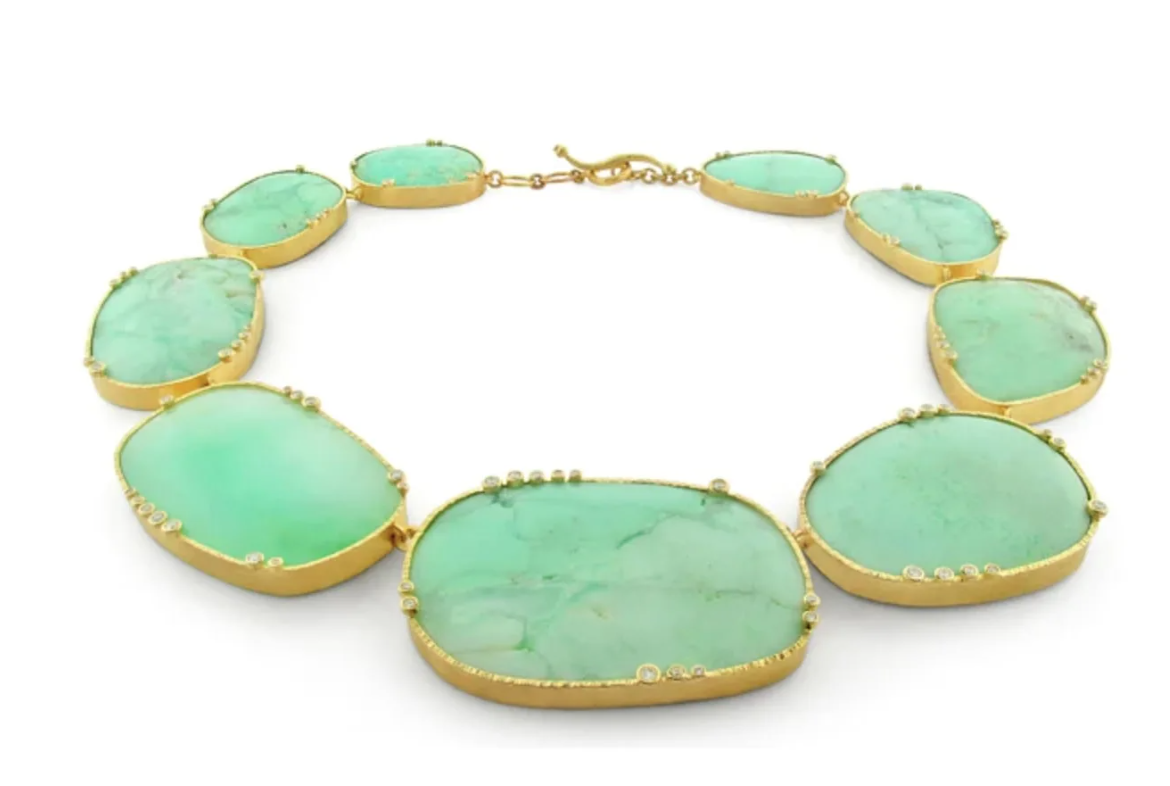
30 Jan Slate Gray Feb.: The Bling Thing!
Thursday, February 1, 2024, marks the second Telluride Arts’ Art Walk of 2024. Participating venues are open 5-8pm, hosting receptions to introduce new exhibits and artists. Throughout the month Slate Gray Gallery presents “From Darkroom to Digital” plus high bling.
Go here for more about Slate Gray.
Go here for more about Telluride Arts and Art Walk.
Please scroll down to read our interviews with Petra Class, Barbara Heinrich and Timo Krapf.

In February, Telluride’s Slate Gray Gallery is all about innovation. That of photographers – Topher Straus, Maggie Taylor and Jerry Uelsmann – each of whom in his or her own unique way broke new ground in the medium. Same goes for the jewelers– Petra Class, Barbara Heinrich and Timo Krapf.
(Please see related story about the fine art photographers.)
And read on to add some sparkle to your life.
The three metal artists share a sense of adventure, a joyful eye and a palpable sense of dare and flair. Their work explodes with energy, brilliance, sensuality and a sense of confidence which, in turn, supports an inclination to create outside conventional norms.
Petra Class:
Trained as a silversmith in Germany but now working in San Francisco, Petra Class was in the stable of the Telluride Gallery for years and now Slate Gray. The way the artist uses the colors of gems is similar to how painters use pigment, ultimately creating unexpected juxtapositions that are beautiful to behold – and to wear. Petra’s uncut gemstones are set into high-karat gold to create works that feature dynamic tension and quiet elegance.

5-Point Gold Ribbon Earring by PC.
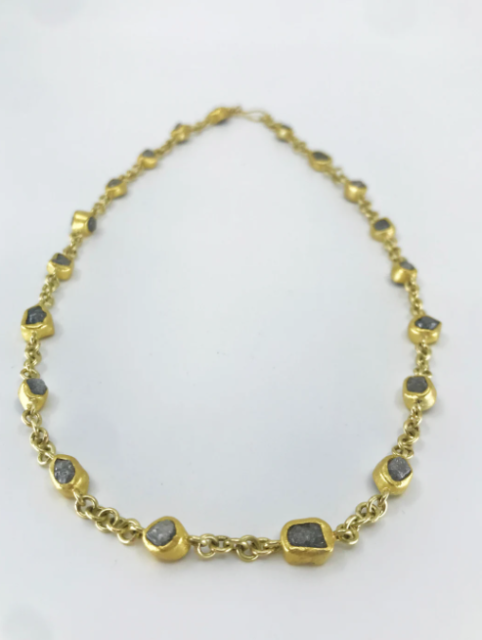
Diamond Crystal Chain, PC.
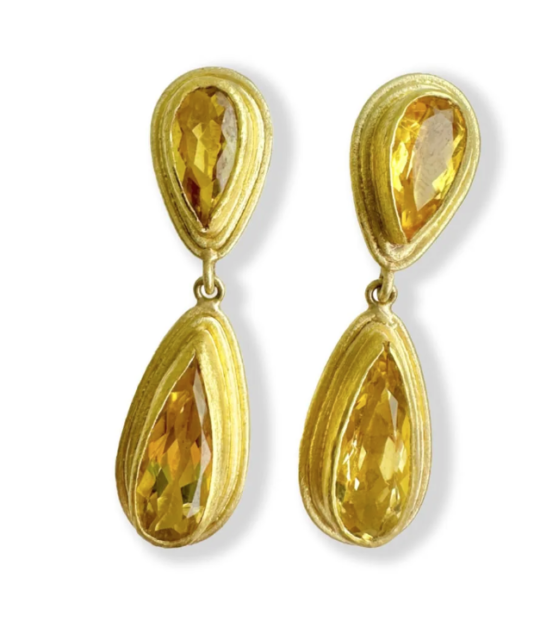
Yelllow Beryl Drop Earrings, PC.
Below are Petra answers questions about her life and work.
TIO: Rumor has it you have a very inventive, very restless mind and are easily bored. If true, how has that mindset impacted your life and your work?
PC: My busy mind has made my life and my work quite colorful – literally and metaphorically.
TIO: Back in Germany where you grew up, your father designed cars and custom hubcaps and your brothers followed careers in science, so you took a left turn away from the practical endeavors of your family. What drew you to the arts versus a more traditional, family-blessed career path?
PC: The arts always have a playful quality to them and I felt very at home in all things artistic from an early age.
TIO: You hold a degree in art history and philosophy, but then you did advanced studies in metal arts. There you studied under Hermann Junger whom you credit with transforming jewelry into an art form. Please explain.
PC: I have to correct this: I didn’t finish my degrees – I switched to art school. Also: Herman Jünger was a friend and role model, I didn’t study under him. My teacher was Nikolaus Epp.
TIO: Why do you think German jewelry-makers have garnered such stellar reputations around the world?
PC: The education system in Germany is quite good. I was able to get a solid foundation in technical aspects of metal-smithing, as well as the design part. Both are needed.
TIO: Please describe the arc of your career from the early 1980s to the present. In what key ways have you and your work evolved and changed?
PC: My work became more playful after I moved to California. In the earlier years of my career I was more minimal and sculptural, then gemstones became an integral part of the design. But I think that in many ways now, as I am maturing (getting old, LOL,) I can use the whole spectrum of forms and colors I have explored in the past and that is a ton of fun.
TIO: In talking about two of your major influences, Piet Mondrian and Alexander Calder, you said: “It’s all about contrast, volume and rhythm.” Please explain both the influence of those artists and what you meant by that statement.
PC: Those two artists are just two great examples. All art is influencing. Mondrian was able in his abstractions to translate the rhythms of nature into more essential minimal shapes. I do the same when I arrange gem elements. Fibonacci could be named as an influence as well. Calder is just one artist who makes me laugh. He was so very playful….
TIO: Please talk about your favorite materials and your creative process.
PC: Gold and gemstones! The creative process is a lot like cooking. Find the flavors that entice me the most and combine them in ways that please the senses…..
TIO: In what ways, if any, did the Telluride Gallery, now Slate Gray, and Telluride itself impact your career?
PC: The Telluride Gallery was a venue that let art and applied art co-exist. And I know Slate Gray shares the same ethos. think that’s a fabulous concept. Telluride itself is a magical place and I can’t wait to be back!
TIO: We held on to your artist statement from back when we last interviewed you in – wait for it – 2006. You concluded that statement by saying: “The one thing that guides me remains the same – to try to listen to the inner quality of each element and create a competition that does it justice.” Does that statement still hold?
PC: Absolutely!
Barbara Henirch:
Raised on a farm with grape vineyards, Barbara Heinrich spent her childhood enthralled by nature. She spent hours exploring her family’s property, collecting broken glass, snail shells, and pods. She strung her findings with dried, dyed noodles to create her very first necklace. Barbara’s organic approach to creating jewelry so early in life set the stage for what would come:
“I’ve wanted to make jewelry from the cradle,” she acknowledges.
Barbara’s parents enrolled her in Pestalozzi Kinderdorf Wahlwies’ four-year apprentice program located in tranquil Lake Constance, Germany. There she learned to hone her spiritual approach to the art of jewel-making.
“The flow of communication between you and the piece should be constant,” she reveals. “I let the piece tell me how to build it.”
Once she completed the program, Barbara took a second apprenticeship at Pforzheim Academy, earning two scholarships, and a Masters of Fine Arts in jewelry and hollowware (silverware and serving dishes). Next, she would travel to New York to study at the Rochester Institute of Technology (RIT), where she earned a second Masters of Fine Arts degree.
Barbara not only excels in manipulating gold, she also highlights multi-gemstone pieces featuring exquisite color combinations such as watermelon tourmaline, emerald, ruby, orange Mexican fire opal, iridescent opals, and purple amethyst.
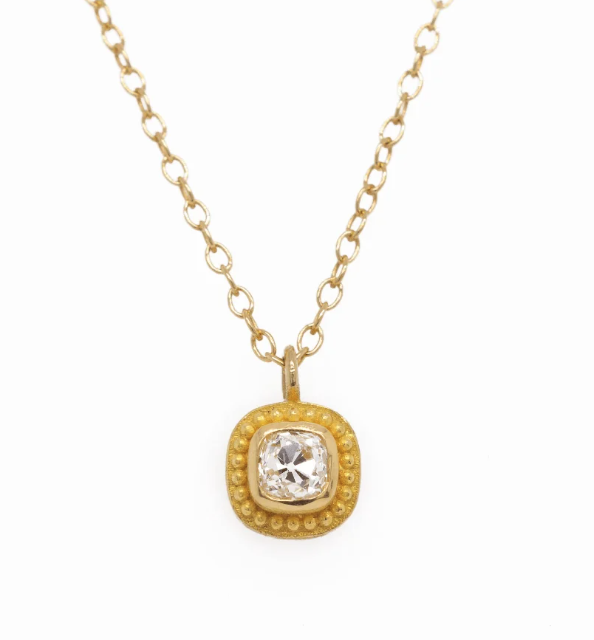
Cushion-shaped Diamond necklace, BH

Grey Spinel Platinum Ring, BH.

Chrysoprase Necklace, BH.
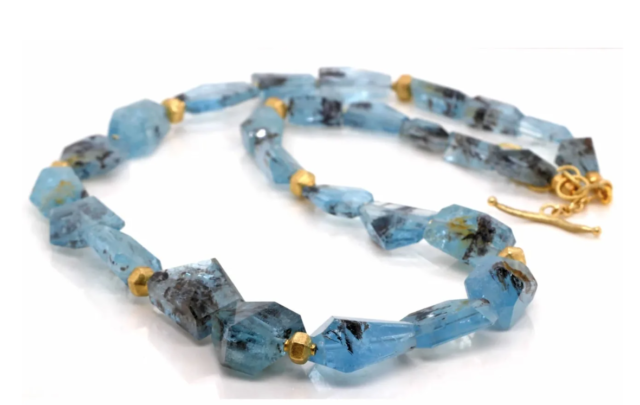
Dendrite Aquamarine Necklace, BH.
Telluride knows all about the award-winning baubles, bangles and beads fashioned by Barbara Heinrich, a force in high jewelry for decades. Collectively the dearly departed Telluride Gallery and now Slate Gray have shown her work in town for over three decades and counting.
“My 35 years in Telluride has inspired my work tremendously, from creating an aspen collection to presenting many one-of-a-kind pieces for locals in town. I love the rawness and genuine unpolished spirit of the region. In my work, I intentionally stay away from mainstream – just like Telluride!! I am so proud to be part – even in a small way – of this community of free spirits! Thank you Telluride for your ever fresh and wonderful vibe !!!!”
In contrast to high-gloss, blown-out, glam-slam bling there is an undeniable and consistent understated elegance to Barbara’s work. In other words, her masterpieces of quiet elegance are the opposite of “statement pieces” that shout for attention.
Bottom line: Barbara Heinrich is all about enhancing the beauty of the wearer with jewelry that goes ‘round the clock and lasts for generations.
“I work with intention, and my intention is not purely aesthetic. I want to touch the soul of the person wearing my pieces and enhance them as spiritual beings.”
Exactly one year ago, Slate Gray’s show featured Barbara’s “Glacier” series, also her colored stone work that symbolized disparate elements coming together or connection, so we asked what her growing fan base can look forward to with regard to her latest collection.
“I like to stay with themes over a long time, and find it very satisfying to expand on them over the years. The theme of “connection” continues to be a leitmotif for my current work. There will be new “connection” pieces that surprise by their colorful and celebratory nature. I have also added a wonderful cuff I named “Ice Edge” to the glacier collection that I am looking forward to showing in Telluride for the first time. It captures the amazing crystallization of water at the edge of a body of water when it freezes.
“To expand on the color palette of the iciness of winter and snow I am also planning to bring a substantial collection of work that focuses on aquamarine as the main gemstone. One of those pieces will be a collar made entirely of large slabs of aquamarine interspersed with slivers of gold and diamonds.
“I am excited to return to Telluride and to reconnect with our customers there in person. I am also available to design one-of-a-kind pieces using gemstones anyone may have on hand.”
Timo Krapf:
Rochester, NY-based jewelry designer and maker Timo Krapf creates elegant, high-quality jewelry through contemporary and traditional gold-smithing techniques. He specializes in a type of metal forming known as Anticlastic Raising which enables Timo to produce exceedingly light, hollow forms with organic, flowing curves. The artist continues to push the boundaries of the technique in an effort to distinguish himself and his work.
From childhood on, Timo was inspired by his mother Barbara Henirich. As an artist, he is drawn to simple, pure forms and pieces with graceful, fluid lines. He uses the contrast of surface finish and color to create excitement and movement.
In 2019, Timo graduated from the Metals and Jewelry Design BFA program at Rochester Institute of Technology He previously graduated from the Jewelry Arts program at George Brown College in Toronto, Ontario.
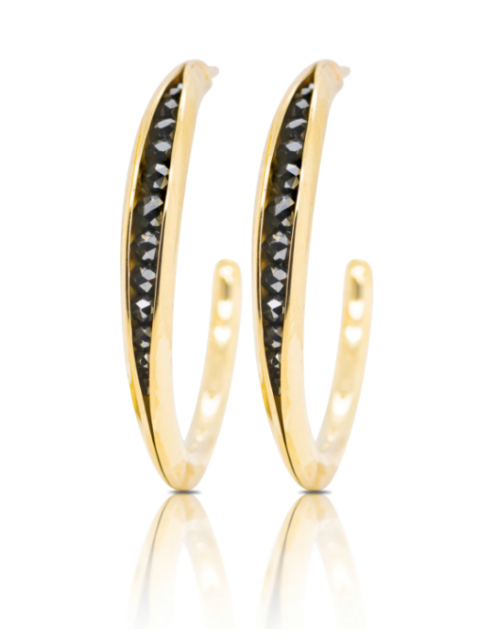
Gold Hoops with Black Diamonds, TK.

Silver Triple Knot Necklace, TK.
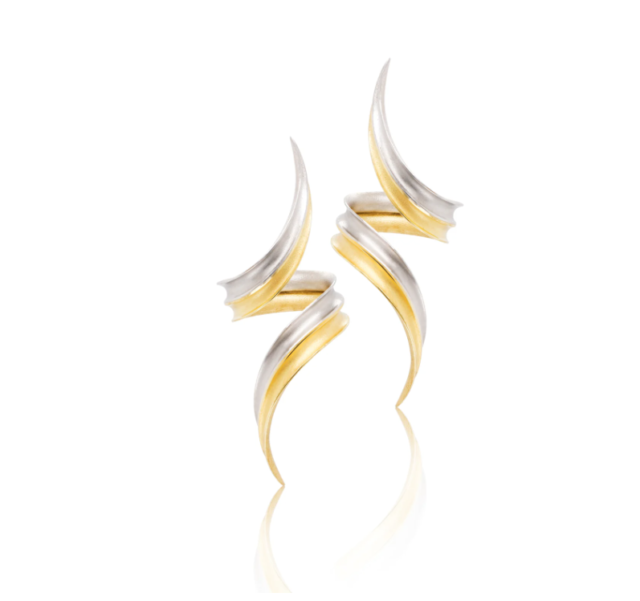
Large Jewel-tone Ribbon Twirl Earrings, TK.
Read on for more from Timo.
TIO: When Slate Gray introduced your work along with your mother’s latest collection you talked to your future fans about the technique you employ, Anticlastic Raising, which you learned from an apprenticeship with a metal artist who was not your mother. Please explain that technique and how it complements your aesthetic. Please describe your aesthetic too.
TK: Anticlastic Raising is a type of metal-forming in which the metal is hammered to create a compound curve so that the two axes of curvature are perpendicular to one another. That creates a saddle-shaped form or a tube with the seam running along the outside. I studied with and learned the technique from renowned jeweler Michael Good.
My work is very form-driven and characterized by graceful shapes, clean lines, and three- dimensionality. I use gemstones and embellishments very sparingly. Instead I create excitement through form, movement, and contrast.
TIO: How do you feel about being side-by-side with your mother who has earned kudos globally for her fine art jewelry.
TK: It has been wonderful to get to work alongside my mother. She has so much experience and knowledge to pass down to me and is great at problem-solving issues whether they are technical, design or business-related. We both like working at the studio when it is quiet and distraction-free and often find ourselves working alongside one another at 2, 3 or 4 in the morning.
It has been particularly fun to show our work together at trunk shows and in various galleries. Our styles are unique and often quite different from one another, however, our work shares an underlying organic, nature motif. We find that our two styles show very well together and that clients and galleries alike love the mother-son narrative.


Sorry, the comment form is closed at this time.